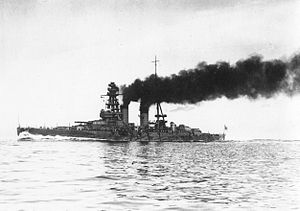Kapal tempur kelas Nagato
 Kapal tempur Jepang Nagato pada 30 September 1920 | |
| Tentang kelas | |
|---|---|
| Nama: | Kelas Nagato |
| Operator: |  Angkatan Laut Kekaisaran Jepang Angkatan Laut Kekaisaran Jepang |
| Didahului oleh: | Kapal tempur kelas-Ise |
| Digantikan oleh: | Kapal tempur kelas-Tosa |
| Dibangun: | 1917–1921 |
| Beroperasi: | 1920–1945 |
| Selesai: | 2 |
| Hilang: | 1 |
| Ciri-ciri umum | |
| Jenis | Kapal tempur Dreadnought |
| Berat benaman | 32.720 t (32.200 ton panjang) (standard) |
| Panjang | 2.158 m (7.080 ft 1 in) (keseluruhan) |
| Lebar | 2.902 m (9.521 ft 0 in) |
| Sarat air | 908 m (2.979 ft 0 in) |
| Tenaga |
|
| Pendorong | |
| Kecepatan | 26 knot (48 km/h; 30 mph) |
| Jangkauan | 5.500 nmi (10.200 km; 6.300 mi) pada 16 knot (30 km/h; 18 mph) |
| Awak kapal | 1.333 orang |
| Senjata |
|
| Pelindung | |
Kapal tempur kelas Nagato (長門型戦艦code: ja is deprecated , Nagato-gata senkan) adalah kapal tempur jenis dreadnought pertama yang dibuat seluruhnya di Jepang. Kapal tempur kelas ini juga merupakan kapal tempur pertama di dunia yang menggunakan meriam ukuran 16 inci, dan juga pada waktu diluncurkan, adalah kapal tempur utama paling hebat di dunia. Akibat dari pembatasan dalam Washington Naval Treaty, maka kelas Nagato lalu menjadi kelas kapal tempur terakhir yang dimiliki oleh Jepang sebelum akhirnya Jepang membuat kelas Yamato pada akhir 1930-an. Ada dua kapal dalam kelas ini, yaitu Nagato dan Mutsu. Nagato pernah menjadi kapal bendera Laksamana Isoroku Yamamoto ketika menyerang Pearl Harbour. Nagato menjadi satu-satunya kapal tempur Jepang yang selamat dari kehancuran dalam Perang Dunia II sebelum akhirnya menemui ajalnya dalam tes bom atom pada 1946. Sementara itu, saudarinya, Mutsu, telah terlebih dahulu karam pada 1943 akibat terjadi ledakan yang diklaim sebagai aksi sabotase.
Referensi
- Campbell, John (1985). Naval Weapons of World War II. Annapolis, Maryland: Naval Institute Press. ISBN 0-87021-459-4.
- Chesneau, Roger, ed. (1980). Conway's All the World's Fighting Ships 1922–1946. Greenwich, UK: Conway Maritime Press. ISBN 0-85177-146-7.
- Evans, David C. & Peattie, Mark R. (1997). Kaigun: Strategy, Tactics, and Technology in the Imperial Japanese Navy, 1887–1941. Annapolis, Maryland: Naval Institute Press. ISBN 0-87021-192-7.
- Friedman, Norman (2011). Naval Weapons of World War One. Barnsley, South Yorkshire, UK: Seaforth. ISBN 978-1-84832-100-7.
- Gardiner, Robert & Gray, Randal, ed. (1984). Conway's All the World's Fighting Ships: 1906–1921. Annapolis, Maryland: Naval Institute Press. ISBN 0-87021-907-3.
- Hackett, Bob; Kingsepp, Sander & Ahlberg, Lars (2009). "IJN Mutsu: Tabular Record of Movement". Combinedfleet.com. Diakses tanggal 15 May 2013.
- Hackett, Bob; Kingsepp, Sander & Ahlberg, Lars (2009). "IJN Nagato: Tabular Record of Movement". Combinedfleet.com. Diakses tanggal 15 May 2013.
- Jentschura, Hansgeorg; Jung, Dieter & Mickel, Peter (1977). Warships of the Imperial Japanese Navy, 1869–1945. Annapolis, Maryland: United States Naval Institute. ISBN 0-87021-893-X.
- Lengerer, Hans (June 2010). Ahlberg, Lars, ed. "Battleships of the Kaga Class and the So-called Tosa Experiments". Contributions to the History of Imperial Japanese Warships (Special Paper I): 1–26.
- Parshall, Jonathan & Tully, Anthony (2007). Shattered Sword: The Untold Story of the Battle of Midway. Washington, D. C.: Potomac Books. ISBN 1-57488-924-9.
- Rohwer, Jurgen (2005). Chronology of the War at Sea, 1939–1945: The Naval History of World War Two. Annapolis, Maryland: Naval Institute Press. ISBN 1-59114-119-2.
- Silverstone, Paul H. (1984). Directory of the World's Capital Ships. New York: Hippocrene Books. ISBN 0-88254-979-0.
- Skwiot, Miroslaw (2007). Nagato Mutsu, Part I. Encyklopedua Okretów Wojennych. 51. Gdansk, Poland: AJ-Press. ISBN 978-83-7237-184-3.
- Skwiot, Miroslaw (2008). Nagato Mutsu, Part II. Encyklopedia Okretów Wojennych. 52. Gdansk, Poland: AJ-Press. ISBN 978-83-7237-202-4.
- Stille, Mark (2008). Imperial Japanese Navy Battleships 1941–45. New Vanguard. 146. Botley, Oxford, UK: Osprey Publishing. ISBN 1-84603-280-6.
- Tully, A.P. (2003). "Nagato's Last Year: July 1945 – July 1946". Mysteries/Untold Sagas of the Imperial Japanese Navy. Combinedfleet.com. Diakses tanggal 26 May 2013.
- Whitley, M. J. (1998). Battleships of World War II. Annapolis, Maryland: Naval Institute Press. ISBN 1-55750-184-X.
- Williams, Mike (2009). "Mutsu – An Exploration of the Circumstances Surrounding her Loss". Dalam Jordan, John. Warship 2009. London: Conway. hlm. 125–142. ISBN 978-1-84486-089-0.
- l
- b
- s
- Didahului oleh: Kapal tempur kelas-Ise
- Disusul oleh: Kapal tempur kelas-Tosa









